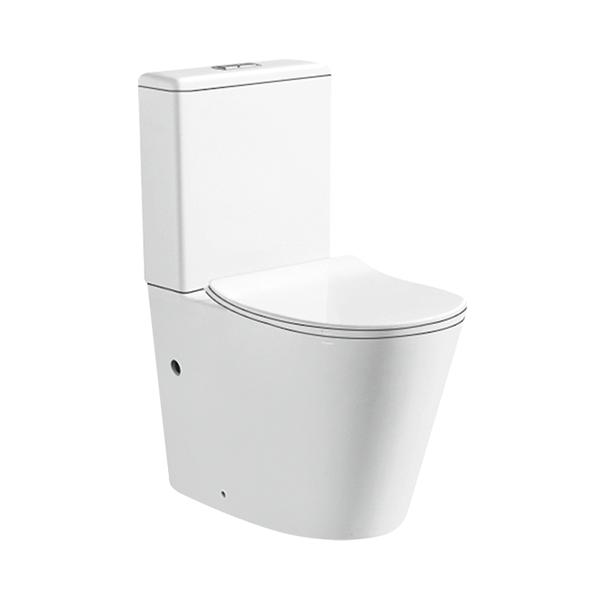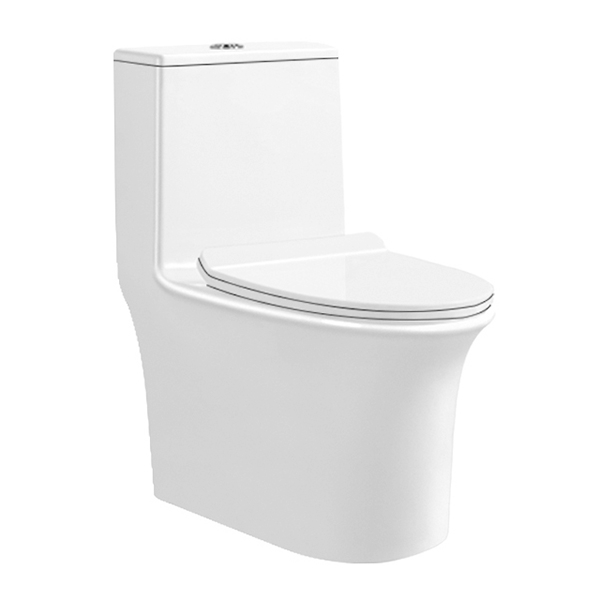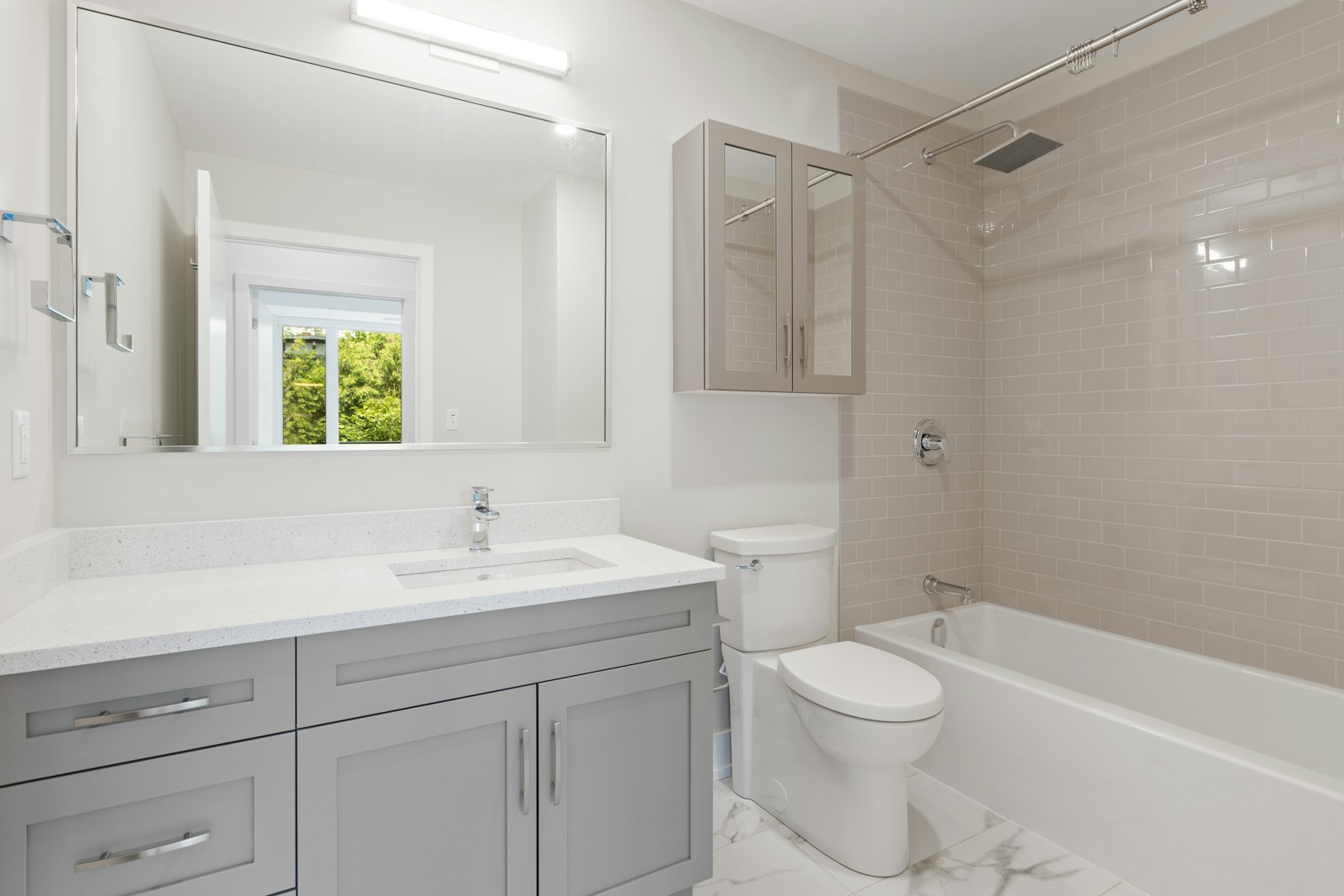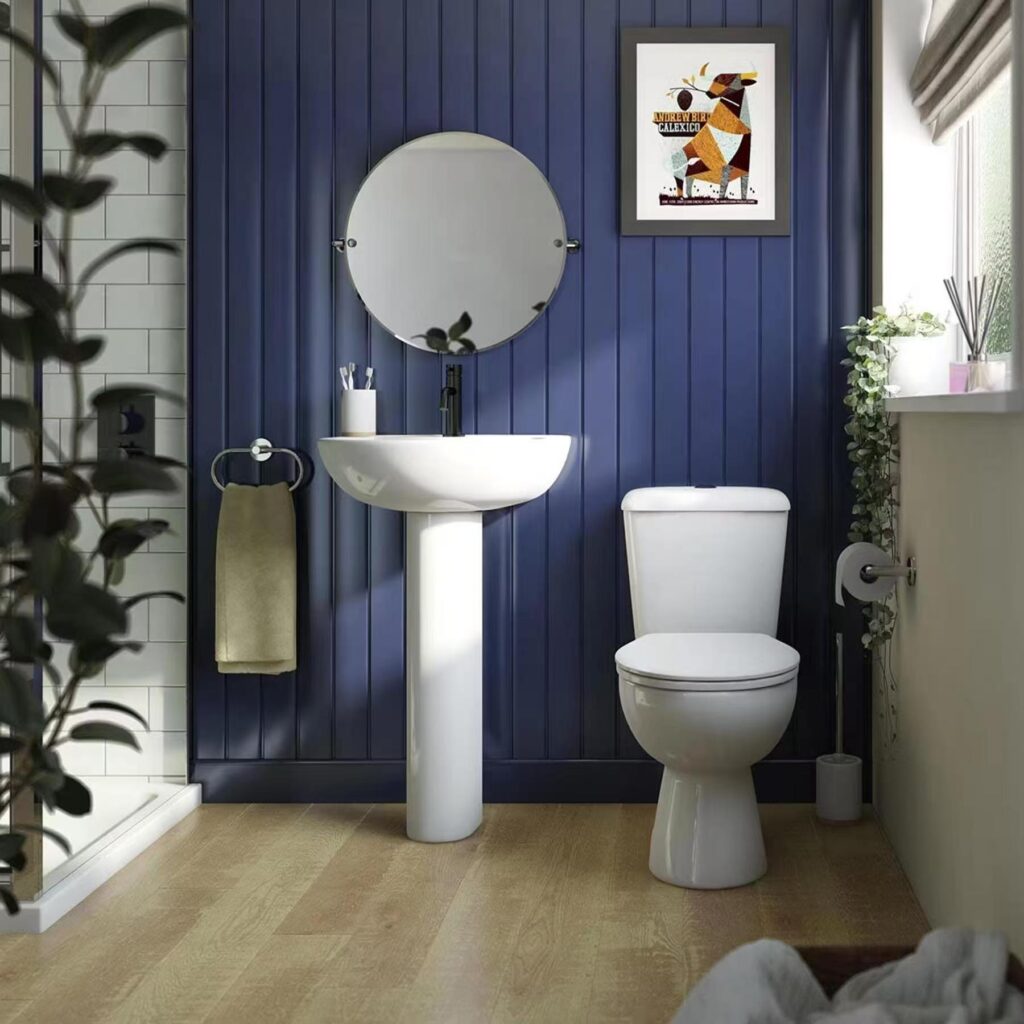Introduction
Designing a commercial restroom for high-traffic spaces is a balancing act that often leaves architects and facility managers frustrated. The challenge? Creating a space that’s durable enough to withstand constant use, accessible to all, and easy to maintain—without sacrificing style or breaking the budget.
It’s a common scenario: A newly renovated public restroom looks pristine on opening day, only to become a maintenance nightmare within months. From inefficient layouts that create bottlenecks to fixtures that can’t stand up to heavy use, the consequences of poor design choices can be costly and time-consuming to correct. But there’s good news: With the right approach, it’s possible to create a commercial restroom that’s both functional and stylish, even in the busiest of spaces.
This guide will walk you through the best practices for commercial restroom design, focusing on key elements like touchless fixtures, space optimization, and ADA compliance. We’ll explore how choosing the right materials—like durable ceramic toilets—can make a significant difference in longevity and ease of maintenance. Whether you’re an architect drafting plans for a new building or a facility manager looking to upgrade existing restrooms, you’ll find practical, actionable advice to create spaces that truly stand the test of time and traffic.
The Importance of Commercial Restroom Design in High-Traffic Spaces
When it comes to high-traffic spaces, commercial restroom design plays a crucial role that often goes unnoticed. Yet, the impact of a well-designed restroom on user satisfaction, operational efficiency, and long-term cost savings is significant. As a veteran in the sanitary ware industry, I’ve seen firsthand how thoughtful design can transform a public restroom from a necessary evil into a “game-changer” for businesses and institutions alike.
Why Restroom Design Matters in Commercial Settings
Commercial restroom design is more than just aesthetics; it’s about creating a functional space that can withstand heavy use while maintaining cleanliness and efficiency. In high-traffic areas, restrooms face unique challenges that require careful consideration during the design phase.
“Effective commercial restroom design balances durability, hygiene, and user comfort to create spaces that can handle high traffic while reducing maintenance costs.”
A well-designed commercial restroom can significantly impact a business’s bottom line. It reduces maintenance costs, improves user experience, and contributes to the overall perception of a facility. Whether it’s an airport, shopping mall, or office building, the restroom often serves as a reflection of the entire establishment’s standards.
Challenges of High-Traffic Restrooms: Wear, Maintenance, and Accessibility
High-traffic restrooms face constant wear and tear, making durability a top priority. Fixtures must withstand frequent use without breaking down or requiring constant repairs. Additionally, these spaces need to be easy to clean and maintain to ensure hygiene standards are met consistently.
Accessibility is another crucial factor. Restrooms must accommodate users of all abilities, complying with ADA standards and providing a comfortable experience for everyone. This often requires careful planning of layout and fixture placement.
How Poor Design Leads to Costly Repairs and User Complaints
Inadequate restroom design can lead to a host of problems. Poorly chosen materials may deteriorate quickly under heavy use, leading to frequent and costly repairs. Insufficient space between fixtures can create uncomfortable situations for users and make cleaning difficult for staff.
User complaints often stem from issues like long wait times, lack of privacy, or unhygienic conditions – all of which can be mitigated through thoughtful design. These complaints can damage a business’s reputation and deter customers or tenants.
The Business Case for Investing in Quality Restroom Solutions
Investing in high-quality commercial restroom design pays dividends in the long run. Durable, easy-to-maintain fixtures like CE-certified ceramic toilets from reliable suppliers such as MFBath can significantly reduce maintenance costs and improve longevity in busy commercial spaces.
| Aspect | Poor Design | Quality Design | Industry Average | MFBath Solution |
|---|---|---|---|---|
| Annual Maintenance Cost | $15,000 | $5,000 | $10,000 | $4,500 |
| User Satisfaction Rate | 60% | 90% | 75% | 95% |
| Average Fixture Lifespan | 3 years | 8 years | 5 years | 10 years |
| Water Consumption (gallons/day) | 1000 | 600 | 800 | 500 |
| Cleaning Time (hours/week) | 20 | 10 | 15 | 8 |
Moreover, there’s a growing trend towards incorporating sustainable and touchless technologies in commercial restroom design. This shift is driven by public health concerns and evolving user experience expectations. By staying ahead of these trends, businesses can create restroom spaces that not only meet current needs but are also future-proof.
In conclusion, the importance of commercial restroom design in high-traffic spaces cannot be overstated. It’s an investment that impacts user satisfaction, operational efficiency, and long-term cost savings. By prioritizing durability, maintenance ease, and modern design principles, businesses can create restroom spaces that stand up to the challenges of high traffic while providing a positive experience for all users.
Leveraging Touchless Fixtures for Hygiene and Efficiency
In the world of commercial restroom design, touchless technology has emerged as a game-changer. As someone who’s spent over a decade in the sanitary ware industry, I’ve witnessed firsthand how these innovative fixtures are revolutionizing high-traffic restrooms. Let’s dive into why touchless solutions are becoming the “go-to” choice for modern, efficient restroom spaces.
The Rise of Touchless Technology: Faucets, Flush Valves, and Dispensers
Touchless fixtures have rapidly gained popularity in commercial restrooms. From motion-activated faucets to sensor-operated flush valves and soap dispensers, these technologies are transforming the user experience. The adoption of these fixtures isn’t just a passing trend; it’s a response to growing demands for improved hygiene and efficiency in high-traffic environments.
“Touchless fixtures in commercial restroom design not only enhance hygiene but also significantly improve user experience and operational efficiency in high-traffic settings.”
At MFBath, we’ve seen a surge in demand for our touchless-compatible ceramic toilets and fixtures. These products are designed to seamlessly integrate into high-traffic restroom projects, ensuring consistency and efficiency through bulk purchasing options.
Benefits of Motion-Activated Fixtures in Busy Environments
The advantages of touchless fixtures in high-traffic restrooms are numerous. First and foremost, they significantly reduce the spread of germs by minimizing surface contact. This is particularly crucial in busy spaces where maintaining cleanliness can be challenging.
Moreover, touchless fixtures contribute to water conservation efforts. Sensor-activated faucets and flush valves can help reduce water waste by ensuring water flows only when needed. This not only supports sustainability goals but also leads to substantial cost savings over time.
Impact on Hygiene Standards and Public Health Perceptions
In the wake of global health concerns, public perception of restroom hygiene has shifted dramatically. Touchless fixtures play a vital role in addressing these concerns. They not only improve actual hygiene levels but also boost user confidence in the cleanliness of the facility.
Commercial restroom design that incorporates touchless technology sends a clear message: the establishment prioritizes health and cleanliness. This can have a positive impact on overall customer satisfaction and brand perception.
Maintenance Advantages of Touchless Systems
From a maintenance perspective, touchless fixtures offer several benefits. They tend to stay cleaner longer due to reduced physical contact, which can lead to less frequent cleaning and maintenance. Additionally, many touchless systems come with diagnostics that can alert staff to issues before they become major problems, aligning with best practices for restroom maintenance.
| Feature | Traditional Fixtures | Touchless Fixtures | Industry Average | MFBath Touchless Solutions |
|---|---|---|---|---|
| Water Usage (gallons/day) | 1000 | 700 | 850 | 650 |
| Maintenance Frequency (times/month) | 8 | 4 | 6 | 3 |
| User Satisfaction Rate | 70% | 90% | 80% | 95% |
| Germ Spread Reduction | 0% | 70% | 50% | 75% |
| Average Lifespan (years) | 5 | 8 | 6 | 10 |
While the initial investment in touchless fixtures may be higher, the long-term benefits in terms of reduced maintenance costs, improved hygiene, and enhanced user satisfaction make them a smart choice for efficient restroom design.
In conclusion, leveraging touchless fixtures in commercial restroom design is more than just following a trend. It’s a strategic decision that can significantly improve hygiene standards, user experience, and operational efficiency in high-traffic settings. As we continue to prioritize public health and sustainable practices, touchless technologies will undoubtedly play an increasingly important role in shaping the future of commercial restrooms.

Space Optimization Strategies for Small and Busy Restrooms
In the world of commercial restroom design, space is often at a premium, especially in high-traffic areas. As a seasoned professional in the sanitary ware industry, I’ve seen firsthand how smart space utilization can transform even the smallest restrooms into efficient, comfortable spaces. Let’s explore some “game-changing” strategies to maximize space in busy commercial restrooms.
Smart Layout Choices: Wall-Hung Toilets and Compact Designs
When it comes to optimizing space in small restrooms, wall-hung toilets are a game-changer. These fixtures not only save valuable floor space but also simplify cleaning processes, making them ideal for high-traffic areas. At MFBath, our wall-hung toilet solutions are designed specifically for large-scale commercial projects with high maintenance demands.
“Effective commercial restroom design in small spaces hinges on smart fixture choices and layout planning, balancing space efficiency with user comfort and accessibility.”
Compact designs don’t stop at toilets. Consider space-saving sinks, corner urinals, and slim-profile hand dryers. These choices can significantly reduce the footprint of each fixture while maintaining functionality.
How to Make Small Restrooms Feel Spacious and Functional
Creating an illusion of space is crucial in small restrooms. Light colors, ample lighting, and large mirrors can make a compact space feel more open. Additionally, consider vertical storage solutions to keep essentials off the counter and floor.
Functionality is key in high-traffic restrooms. Opt for fixtures that serve multiple purposes, such as combining trash receptacles with paper towel dispensers. This approach to public restroom layout not only saves space but also enhances user experience.
Balancing Traffic Flow with Accessibility Requirements
Designing for high traffic while ensuring accessibility can be challenging in small spaces. Start by creating a clear path through the restroom that accommodates peak usage times. Place high-use fixtures, like sinks, near the entrance to prevent bottlenecks.
When it comes to accessibility, remember that ADA requirements are non-negotiable. Plan your layout to include the necessary turning radiuses and reach ranges. Wall-hung fixtures can be particularly helpful here, as they allow for flexible height adjustments.
Cleaning Efficiency Through Space-Saving Fixtures
Maintenance efficiency is crucial in busy restrooms. Wall-hung toilets and floating vanities not only save space but also simplify cleaning processes. These fixtures allow easy access to floor areas, reducing cleaning time and improving overall hygiene.
| Feature | Traditional Layout | Space-Optimized Layout | Industry Average | MFBath Solution |
|---|---|---|---|---|
| Floor Space Savings | 0% | 25% | 15% | 30% |
| Cleaning Time (minutes/day) | 60 | 40 | 50 | 35 |
| User Capacity (per hour) | 30 | 40 | 35 | 45 |
| Accessibility Compliance | Partial | Full | Mostly Full | Full+ |
| Maintenance Costs ($/year) | 5000 | 3500 | 4250 | 3000 |
When selecting commercial toilets and other fixtures, consider their long-term maintenance requirements. Durable, easy-to-clean materials can significantly reduce upkeep time and costs in high-traffic settings.
Remember, the goal of space optimization in commercial restroom design isn’t just about fitting more into less space. It’s about creating an environment that functions efficiently, meets all regulatory requirements, and provides a positive user experience, even in the busiest of settings.
By implementing these strategies and choosing the right fixtures, you can transform small, busy restrooms into spaces that are not only functional but also comfortable and efficient. As we continue to see advancements in sustainable and touchless technologies, these space-saving solutions will become even more critical in meeting the evolving expectations of public restroom users.

Ensuring ADA Compliance and Durability in Restroom Design
When it comes to commercial restroom design, particularly in high-traffic environments, two factors stand out as critical: ADA compliance and durability. As a seasoned professional in the sanitary ware industry, I’ve seen firsthand how these elements can make or break a restroom’s functionality and longevity. Let’s dive into why these aspects are non-negotiable in modern restroom planning.
Key ADA Requirements: Stalls, Grab Bars, and Fixture Heights
The Americans with Disabilities Act (ADA) sets forth specific guidelines to ensure restrooms are accessible to all users. These requirements cover everything from stall dimensions to the placement of grab bars and the height of fixtures. For instance, accessible toilet stalls must have a minimum width of 60 inches, with grab bars installed on the side and rear walls.
“ADA-compliant commercial restroom design not only ensures accessibility for all users but also enhances overall functionality and user satisfaction in high-traffic environments.”
At MFBath, our range of ADA-compliant ceramic toilets is designed to meet these stringent requirements while maintaining aesthetic appeal. These fixtures are available in bulk, ensuring consistent quality across multi-site commercial developments.
Blending Accessibility with Modern Aesthetics
Gone are the days when ADA compliance meant sacrificing style. Modern commercial restroom design seamlessly integrates accessibility features with contemporary aesthetics. For example, sleek grab bars can double as towel racks, and wall-mounted sinks with knee clearance can feature elegant, minimalist designs.
The key is to view ADA requirements not as limitations, but as opportunities for innovative design solutions that benefit all users, regardless of ability.
Selecting Durable Materials: Ceramic Toilets and Vandal-Resistant Fixtures
In high-traffic restrooms, durability is paramount. Ceramic toilets remain a top choice for their longevity and ease of maintenance. They resist scratches, stains, and are less prone to damage compared to other materials.
When selecting commercial toilets, look for features like concealed trapways and skirted designs. These not only enhance the aesthetic appeal but also simplify cleaning and reduce potential hiding spots for bacteria.
Long-Term Performance in High-Traffic Settings
Investing in durable toilets for public restrooms pays off in the long run. High-quality fixtures require less frequent replacement and maintenance, leading to significant cost savings over time. They also contribute to a more positive user experience, as well-maintained restrooms reflect positively on the overall perception of a facility.
| Feature | Standard Fixtures | ADA-Compliant Durable Fixtures | Industry Average | MFBath ADA-Compliant Solutions |
|---|---|---|---|---|
| Expected Lifespan (years) | 5-7 | 10-15 | 8-10 | 15+ |
| Annual Maintenance Cost ($) | 2000 | 1000 | 1500 | 800 |
| User Satisfaction Rate | 70% | 90% | 80% | 95% |
| Accessibility Compliance | Partial | Full | Mostly Full | Full+ |
| Vandalism Resistance (1-10 scale) | 5 | 8 | 6 | 9 |
It’s worth noting that there’s a growing trend towards incorporating sustainable and touchless technologies in commercial restroom design. This shift is driven by public health concerns and evolving user experience expectations. When combined with ADA compliance and durability considerations, these innovations create restrooms that are truly “future-proof”.
In conclusion, ensuring ADA compliance and durability in high-traffic restroom design is not just about meeting regulations or saving on maintenance costs. It’s about creating inclusive, long-lasting spaces that enhance the overall user experience. By prioritizing these aspects and choosing high-quality fixtures from reputable suppliers like MFBath, facility managers and designers can create restrooms that stand the test of time and usage.

Enhancing User Experience with Sustainable Design Trends
In the ever-evolving world of commercial restroom design, the focus has shifted dramatically towards sustainability and user experience. As a veteran in the sanitary ware industry, I’ve witnessed firsthand how these trends are reshaping the way we approach high-traffic restroom spaces. Let’s explore how modern design trends are creating more eco-friendly and user-centric restrooms that are truly “next-level”.
Current Trends: Ambient Lighting, Neutral Colors, and Intuitive Layouts
Today’s commercial restrooms are moving away from harsh, clinical environments. Ambient lighting creates a more welcoming atmosphere, while neutral color palettes offer a sense of calm. Intuitive layouts ensure easy navigation, even in busy periods. These elements combine to create spaces that are not just functional, but also pleasant to use.
“Modern commercial restroom design balances sustainability with user comfort, incorporating eco-friendly materials and intuitive layouts to enhance the overall experience in high-traffic spaces.”
At MFBath, we’ve embraced these trends in our product designs, ensuring our fixtures complement these modern aesthetics while maintaining their durability and efficiency.
Incorporating Sustainability: Water-Saving Fixtures and Eco Materials
Sustainability is no longer an option; it’s a necessity. Water-saving fixtures, such as low-flow toilets and sensor-activated faucets, are becoming standard in efficient restroom design. These sustainable restroom products not only reduce environmental impact but also lead to significant cost savings over time.
Eco-friendly materials are also gaining traction. From recycled tiles to bamboo partitions, these materials offer both sustainability and style. MFBath is at the forefront of this trend, offering water-saving ceramic toilets that meet green building standards while supporting cost-effective bulk procurement for large-scale projects.
User-Centric Design: Comfort, Privacy, and Stress Reduction
User experience is paramount in modern restroom design. This means considering factors like comfort, privacy, and stress reduction. Full-length stall doors, sound-masking systems, and well-placed mirrors are just a few examples of how design can enhance user comfort and privacy.
Stress reduction elements, such as nature-inspired artwork or calming color schemes, can turn a restroom visit from a necessary task into a moment of respite in a busy day. These small touches can significantly impact user satisfaction and overall perception of a facility.
Balancing Style with Practicality in High-Traffic Spaces
While style is important, practicality cannot be overlooked in high-traffic restrooms. The key is finding a balance. Durable materials that are easy to clean and maintain are essential. This is where best practices for restroom maintenance come into play, ensuring that the space remains functional and attractive over time.
| Feature | Traditional Design | Modern Sustainable Design | Industry Average | MFBath Sustainable Solutions |
|---|---|---|---|---|
| Water Savings (gallons/year) | 0 | 100,000 | 50,000 | 120,000 |
| Energy Efficiency (kWh/year) | 10,000 | 5,000 | 7,500 | 4,000 |
| User Satisfaction Rate | 70% | 90% | 80% | 95% |
| Maintenance Costs ($/year) | 5,000 | 3,000 | 4,000 | 2,500 |
| Eco-Certification Compliance | None | LEED Gold | LEED Silver | LEED Platinum |
Commercial restroom design is increasingly incorporating touchless technologies, driven by public health concerns and evolving user expectations. These innovations not only enhance hygiene but also contribute to the overall efficiency and sustainability of the space.
In conclusion, enhancing user experience through sustainable design trends is more than just a passing fad. It’s a fundamental shift in how we approach commercial restroom design. By focusing on user comfort, sustainability, and practicality, we can create spaces that are not only environmentally responsible but also genuinely pleasant to use. As we continue to innovate at MFBath, we’re excited to be part of this evolution, offering solutions that meet the demands of modern, high-traffic restrooms while prioritizing user experience and sustainability.

Conclusion
After years in the sanitary ware industry, I’ve seen firsthand how crucial thoughtful commercial restroom design is. It’s not just about aesthetics—it’s about creating spaces that can handle the demands of high traffic while still feeling welcoming and efficient.
From touchless fixtures that boost hygiene to space-saving solutions that maximize functionality, every detail matters. And let’s not forget the importance of ADA compliance and durability—these aren’t just checkboxes, but essential elements that ensure your restroom serves everyone effectively for years to come.
Remember, a well-designed commercial restroom is a “win-win”—it enhances user experience, reduces maintenance headaches, and ultimately reflects positively on your entire facility. So, whether you’re renovating or starting from scratch, investing in quality design and materials isn’t just smart—it’s essential for success in today’s competitive market.
FAQ
-
Q1: What are the key features of effective commercial restroom design?
A1: Effective commercial restroom design incorporates accessibility, durability, and maintenance ease. It often includes touchless fixtures, appropriate materials for high-traffic use, and a layout that maximizes space while ensuring user comfort and safety.
-
Q2: How can I design a high-traffic commercial restroom?
A2: To design a high-traffic commercial restroom, focus on durable materials, efficient layouts, and amenities such as touchless fixtures. Installing adequate partitions and ensuring proper circulation helps accommodate large numbers of users without compromising comfort.
-
Q3: What are the latest trends in commercial restroom design?
A3: Latest trends in commercial restroom design include touchless technology, sustainable materials, and gender-neutral facilities. There’s also an emphasis on enhancing aesthetics while prioritizing hygiene and user experience.
-
Q4: How do I ensure my commercial restroom is ADA compliant?
A4: To ensure ADA compliance in commercial restrooms, follow guidelines for accessible features such as grab bars, appropriate sink height, and adequate space for mobility devices. Ensure signage is clear and legible, and that pathways are unobstructed.
-
Q5: What are durable materials for commercial restrooms?
A5: Durable materials for commercial restrooms include ceramic tiles, stainless steel fixtures, and high-density polyethylene partitions. These materials are designed to withstand heavy use, resist water damage, and facilitate easy cleaning.
-
Q6: How can I optimize restroom maintenance?
A6: To optimize restroom maintenance, select easy-to-clean materials, implement consistent cleaning schedules, and provide touchless fixtures to reduce dirt and germs. Additionally, training staff to identify maintenance issues early can enhance restroom longevity.
-
Q7: What should be considered in public restroom layout?
A7: Public restroom layout should consider circulation flow, user privacy, and accessibility. Designs should also include adequate space for queues, ensure proper ventilation, and maintain clear signage for easier navigation.
-
Q8: How can touchless technology enhance restroom design?
A8: Touchless technology enhances restroom design by promoting hygiene, reducing the spread of germs, and creating a more convenient user experience. Features like automatic faucets, soap dispensers, and hand dryers contribute to a modern facility.
External Links
- Evolving Trends in Commercial Restroom Design: A Glimpse into the Future
- Commercial Restroom Layout – | American Specialties
- 5 Considerations for Commercial Restroom Design – Neumann Monson
- Navigating Commercial Restroom Design in 2023 | PHCP Pros
- Quick Guide to Commercial Restroom Design – e-architect
- Commercial Restroom Design Guide – One Point Partitions
- Top Commercial Restroom Design Trends for 2025: Embracing Wellness, Sustainability, and Technology
- Commercial Restroom Design Guide – Key Questions to Consider – HH Ross







